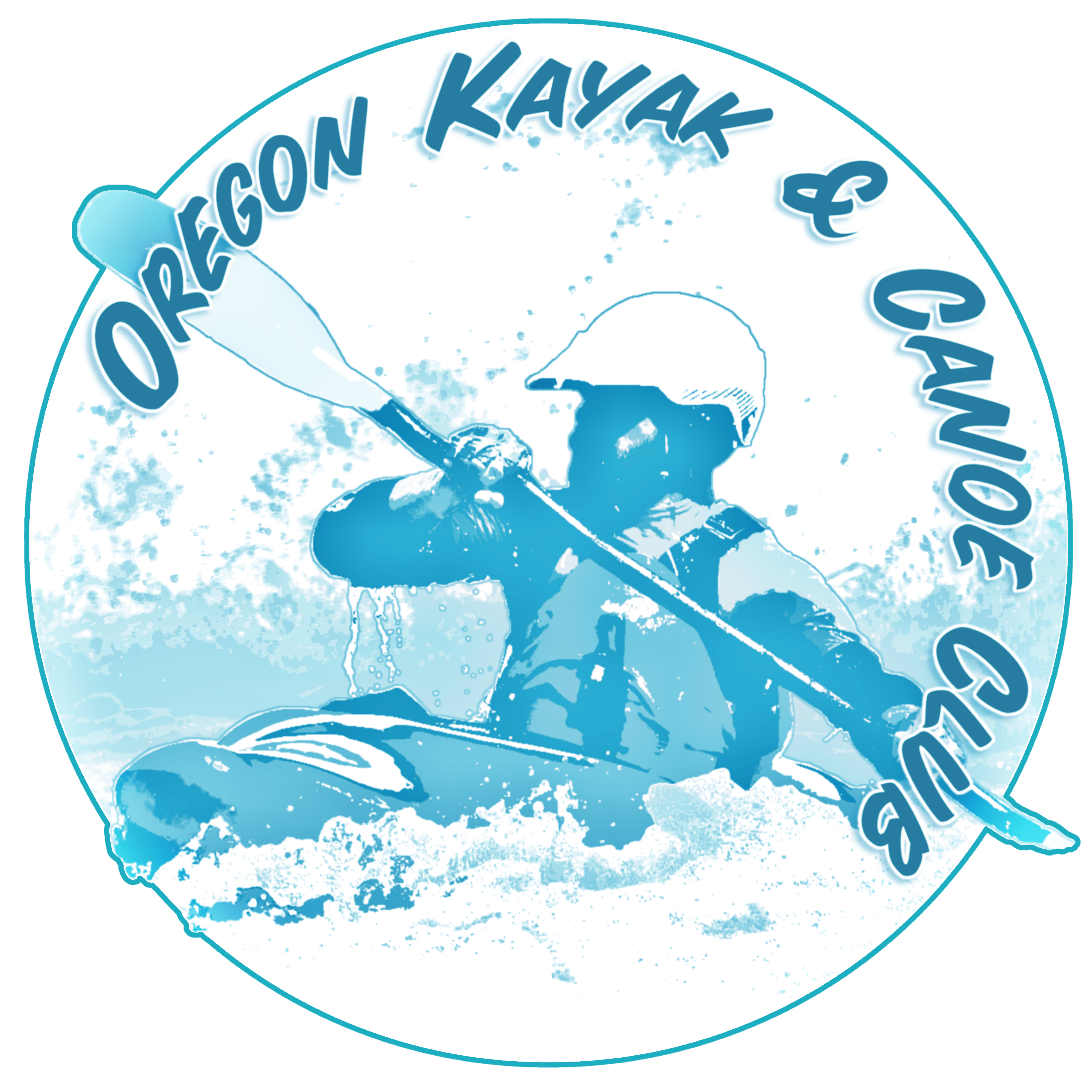History of the OKCC
The Roots of Paddling Oregon's Whitewater
Beginnings of the Oregon Kayak and Canoe Club
by Bob Blickensderfer
In the Beginning
Today’s kayaks are the result of a long evolutionary process that started with the kayaks used by the indigenous peoples of the Arctic regions. The early kayaks were used for hunting in the ocean and transporting goods needed for survival in the Arctic. In contrast, todays kayaks are for fun and sport.
Most early kayaks had a single hatch for one person, the hunter, who was sealed with a skirt to keep out water. Some kayaks had two or more hatches. Kayaks for hauling goods were open on the top. Boats were constructed of ribs of graduated sizes made of bone, or wood from driftwood, spaced along the length of the boat. Longitudinal stringers were sewn to the ribs with animal sinews. The structure was covered with seal or sea lion skin. The boats were narrow and often 20 or more feet long.
By the late 19th century, canvas replaced the animal skins on both kayaks and birchbark canoes of North America. The canvas was stretched over the frame and waterproofed with pitch, or beeswax, or by rubbing clay into the fabric and painting it. Around the early 1900’s, the sport of kayaking first developed in southern Germany on rivers running from the Alps. The kayak was assembled on the bank and then inserted into its fabric skin. It was called das Faltboot, or foldboat. With the development of vinyl coated fabrics, boat skins were further improved, and both kayaks and canoes of this construction were popular into the 1950’s.
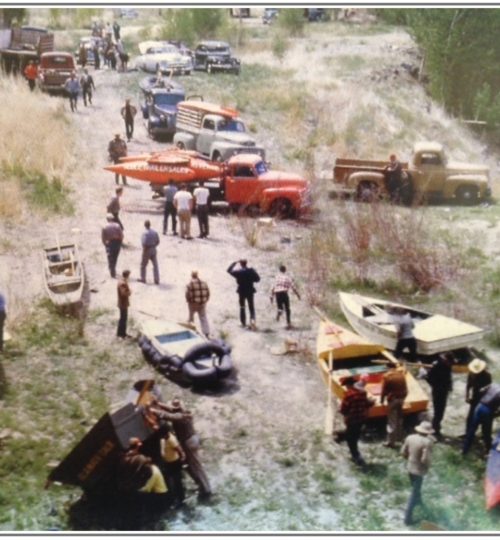
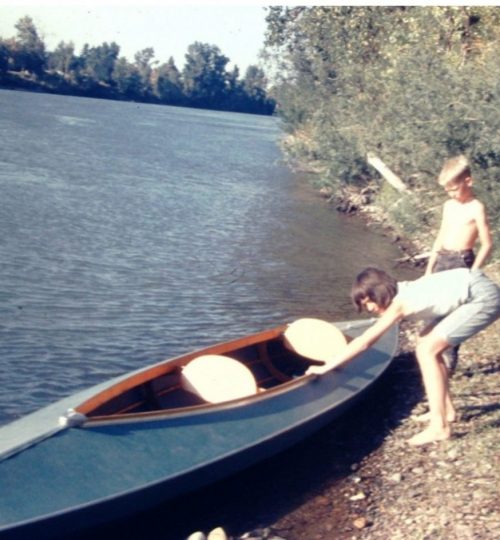
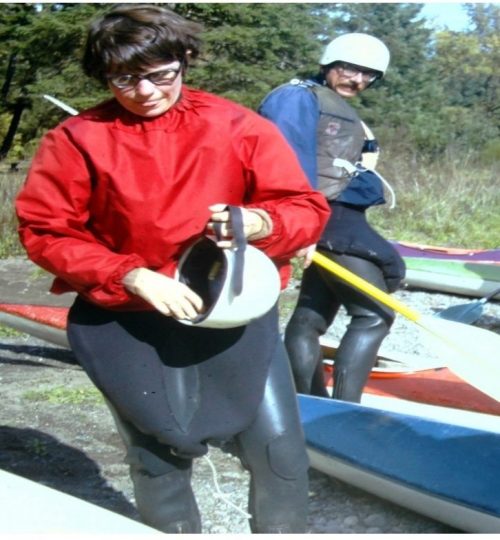
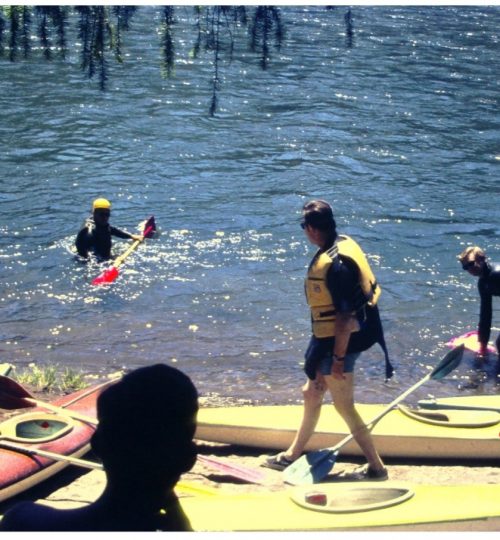
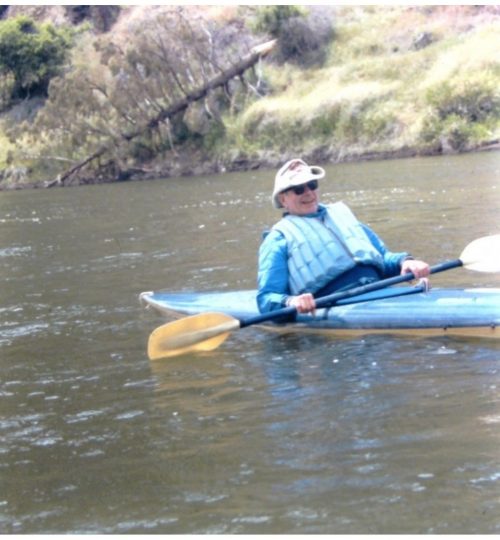
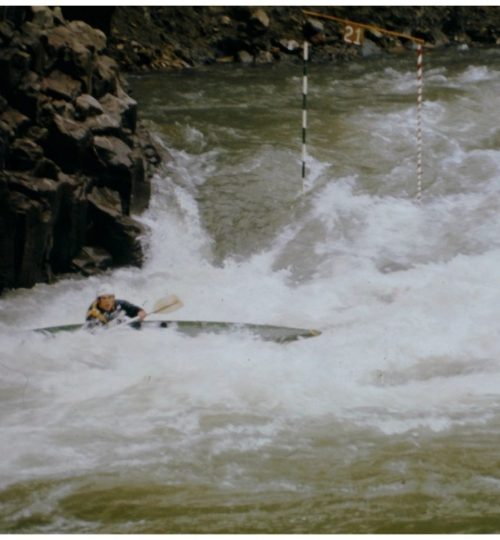
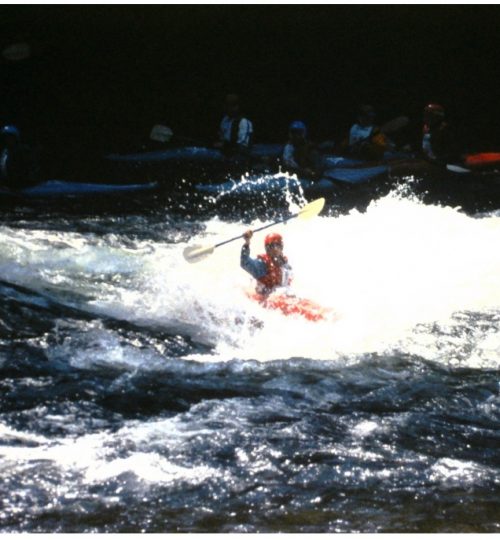
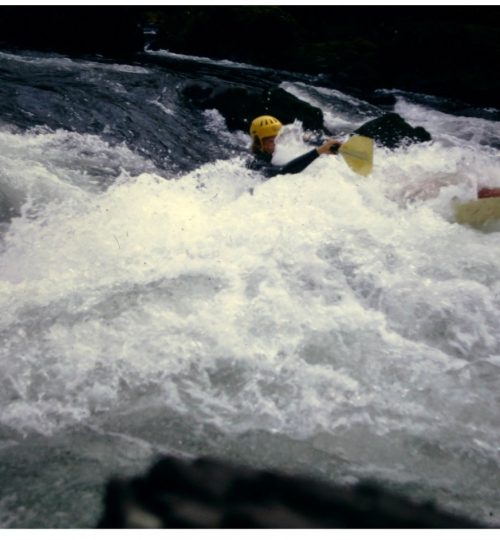
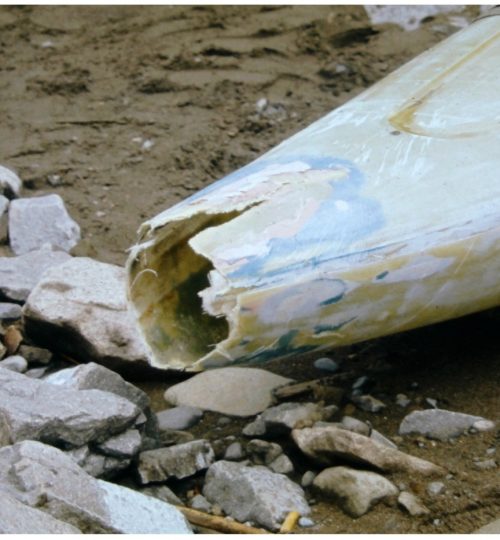
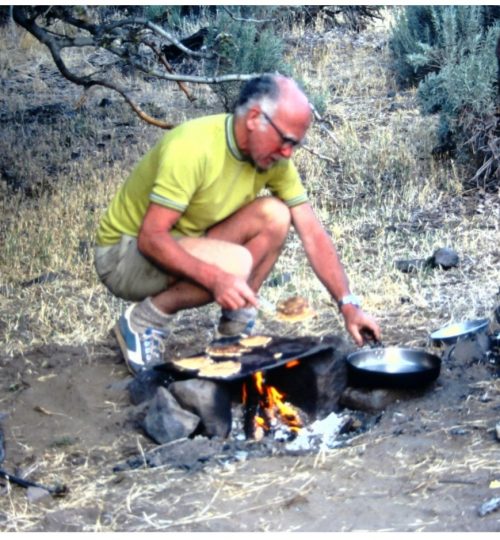
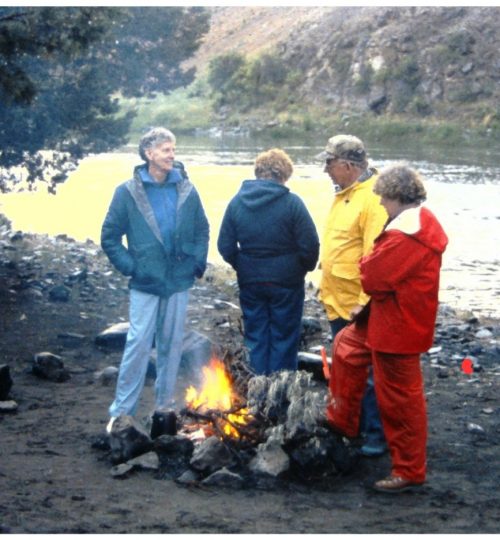
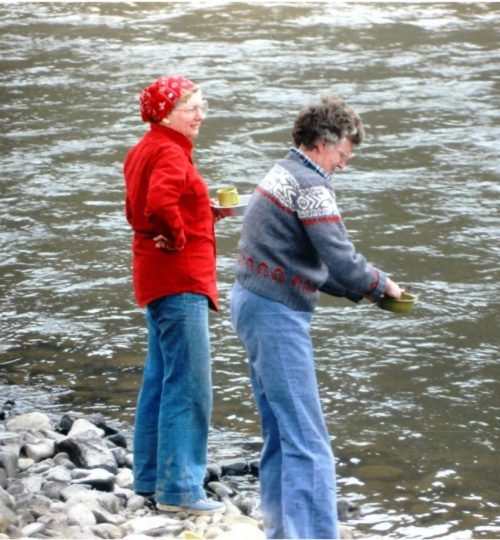
The Great Leap Forward
In the mid-1950’s kayak construction changed drastically. Fiberglass-epoxy composites, developed in the 1940’s, allowed kayaks to be constructed without a frame. The hull and deck were each made from layers of fiberglass and epoxy. After curing, the hull and deck were united with a seam of fiberglass-epoxy completely around the kayak. In Europe fiberglass kayaks and decked canoes, which are very similar to kayaks, gave birth to the sport of whitewater boating. Slalom racing became very popular and the sport grew in Europe. Various kayak hull designs were developed but the hull length was standardized at 4 meters. That length was agreed upon to level the playing field for all slalom racers. These fast, sleek, maneuverable kayaks appeared in New England around 1960 and began to spread in the United States. From New England the fiberglass kayaks and the sport of whitewater kayaking spread quickly to the rivers of Appalachia, Minnesota-Wisconsin, The Ozarks, Colorado, California, and Washington.
Meanwhile in Oregon...
Even though Oregon had some of the finest whitewater rivers in the country, we were among the last places in the U. S. to see the sport of whitewater kayaking develop. When I came to the Willamette Valley in 1959 I saw no kayaks and only an occasional canoe. During the1960’s a few foldboat kayaks appeared. Some were the folding take-apart type, others were the fixed rigid-frame type. Being 16 to 18 feet in length, these kayaks were fast on flatwater, but in whitewater were difficult to maneuver through rapids while avoiding rocks or other obstacles. Tandem canoes were sometimes seen in Oregon. Most were made of aluminum and had a full-length keel. Canoers paddled mostly flat water and class 1 rivers. McKenzie River drift boats, however, had been used in Oregon by fishers since the1920’s or earlier. Skilled rowers could run class 2 and 3 rapids. The boats were a smaller version of the New England dory used for fishing off the Atlantic Coast. Prince Helfrich of Eugene was a well-known drift boat guide who made first descents on several Oregon rivers, including the Owyhee. Thus, the only boats in Oregon capable of running class 3 rapids were McKenzie River boats. But, things were about to change.
The Arrival of Scott & Margie Arighi
Scott Arighi, who had learned to kayak in Wisconsin, came to Oregon in 1964. He found it difficult to find other paddlers. In 1967 his friend Margie Smith came from Wisconsin as the co-leader of a University of Wisconsin Hoofers trip on the Lower Salmon River. They paddled an OC-2, tandem canoe, together. It went so well that Margie returned to Oregon a year later to marry Scott. However, Margie told me that “Soon after we were married, the canoeing harmony was over. We started paddling single kayaks and continued boating happily together ever since.” The first kayak rolling classes in Oregon were taught by the Arighis, according to Scott “… in 1969 or 1970.” Scott was a chemistry professor at Reed College and got permission to use their pool. As the paddling group in the Portland area grew, things became more organized and they scheduled river trips. The date that the Arighis officially formed OKCC is not certain, but my old notes indicate, and the Arighis agree, it was probably 1969. Scott Arighi was the first president and Margie Arighi the first secretary. In 2015 at age 92, Bob Collmer told me that he was the first member to sign up.
The earliest newsletter I have is a hand written single page post marked 27 April 1971. It is the Spring schedule from March 7 through May 31 with 19 trips scheduled. Most were on Saturdays and Sundays and include upper Wilson, upper Molalla, Nahalem exploratory, North Santiam, Washougal, Clackamas, Kalama, Sandy, upper McKenzie, and Toutle Gorge. The trip leaders included the Arighis, Clark Stanley, Bob Collmer, Lloyd Likens, Bev Karplus, and Jay and Jed Langley. The Arighis led nine trips! This small group of early OKCC kayakers was obviously very active. The OKCC grew rapidly as other members, including Rod Kiel, a kayaker from Germany, Spencer Beebe, and Hugh Dick, joined the Club. The Arighis also were the first kayakers to explore many of the rivers in Oregon.
In 1970 OKCC put on the first slalom kayak race in Oregon. It was on the Roaring River section of the Clackamas River. Some of the kayakers got knocked over in the race. Not all could roll back up I believe it was in 1971 that the Bob’s Hole event was started on the Clackamas River. Bob’s Hole was named for Bob Brietenstein because every time he kayaked the Clackamas River he tried to punch the hole, and every time it ate him. The event involved playing in Bob’s Hole. Judges gave points for the quality and finesse of each paddler. This became an annual event for many years.
In the spring of 1970 the OKCC offered a beginning kayaking class organized by Scott and Margie Arighi who were also the principal instructors. Bob Collmer and Lloyd Likens helped with instruction and rescue. The first session was on the lower Sandy River where they taught basic strokes and eddy turns with a low brace. Eight of us beginners from Corvallis took the course and some of us continued boating regularly with OKCC. Later, in 1975, Chuck Leach and I, with others in the Corvallis region, formed our own club, the Willamette Kayak and Canoe Club. A few years later, a group of flat water canoers in Portland, who had been paddling together for several years, founded the Lower Columbia Canoe Club. The exact date is not known, but according to Dennis Deck, a canoer in that early group, it was probably 1979 or 1980.
The decked canoe made its appearance in Oregon in 1971 when Jay and Jed Langley joined the OKCC. The decked canoe is more like a kayak than a canoe. The cockpit, spray skirt, hull shape, and length are similar to a kayak and it behaves much like a kayak. Technically, it’s a canoe because the paddler kneels and uses a single blade paddle. Most of us had never seen a decked canoe before. About 1973, decked canoe paddlers Bruce and Genny Weber arrived in Oregon and also joined the OKCC. Bruce had raced in National competitions. The decked canoe never gained popularity in Oregon. The cramped kneeling position and a very small cockpit were quite uncomfortable, which resulted in its demise.
Finding Boats and Equipment
Finding kayaks for sale in the early years was very difficult because none of the manufacturers we know today existed. In Europe, however, kayaks were being manufactured. As boats made their way to the U. S. they could be replicated. In the late 1960’s a small fiberglass shop in Portland that built fiberglass water tanks began making kayaks from molds taken from two kayaks that OKCC members had purchased from Europe – a Prijon and a Mandesta , German and Italian slalom racing designs. The cost was $150. Quite a few were made the early 1970’s, and they were popular among Oregon’s kayakers. All kayaks were the still the same length, 4 meters or 13 ft 2 in. About this time the superior Mark IV kayak, from Germany, appeared in the eastern US and made its way to Oregon. Easy Rider in Washington State started making the German Augsburg kayak, a well-liked boat. The first roto-molded plastic boat, the Hollowform, appeared in the mid 1970’s, but it’s poor performance and susceptibility to hull cracking soon gave it a bad reputation. It was nicknamed “The Slug”.
We had to make our own spray skirts — from coated nylon. Helmets were desired, but not available. Some boaters used bike helmets. I recall a three-day OKCC trip on the Deschutes River during which Rod Keil wore only a gentleman’s fedora, for sun protection. Flotation — we hadn’t heard of it, but when we did, we stuffed an old inner tube into the stern and a beach ball into the bow. Most paddles were made entirely of wood and were 86 to 92 inches (218 to 234 cm) long. Clark Stanley and Scott Arighi began making shorter paddles with larger, flat, fiberglass blades on aluminum shafts. All paddles had a 90-degree feather. If the blades were asymmetrical in shape, the paddle became either a right-hand or left-hand control. The standard was left-hand control, so most of us were left-hand control paddlers. By 1975 Bob Collmer of the OKCC began making very good paddles in his garage. The paddles had fiberglass blades on an aluminum shaft. I conducted bend and strength tests on his fiberglass–resin composites to help him optimize the types of epoxy and fiberglass lay-ups. Bob built many Collmer paddles until he sold his business to Hank Hays, an expert OC-1 paddler and an OKCC member. Hank continued the business as Lightning Paddles until selling the business in 2008 to a company in Germany.
By the beginning of the 1980s, fiberglass kayaks were essentially replaced by the new roto-molded plastic boats. These boats were much tougher and very resistant to hard knocks which would nearly destroy a fiberglass boat. It was about this time also, when the length of boats began shrinking. These shorter, tougher boats allowed boaters to make amazing moves with abandon and little concern over wrecking the boat.
River Camping Trips
The Arighis loved extended river trips with camping along the river. Quite a few kayakers experienced their first overnight self-supported river trip by boating with the Arighis. During the 1960’s the Arighis were the first kayakers to lead kayakers down several sections of the John Day River. They also led overnight trips down the Grande Ronde River, and the Deschutes River. These trips were always self-supported because there were no rafters to carry gear. Large rafts, outfitted with rowing frames, and rowed with the techniques used by driftboat oarsmen, had not yet appeared in this area. Such rafts existed, but they were owned and operated primarily by river guides on the Colorado Grand Canyon, the Rogue, the Salmon of Idaho, and a few other rivers. These rafts and those owned by individuals were war surplus life rafts from WW2. Rafts rapidly gained popularity because they were much more forgiving than wooden dories and driftboats.
The Arighis developed packing systems that would allow them to easily put all the necessary gear into a kayak. Dry bags, as we know them today, had not yet been developed. But heavy-duty rubber bags were found in WW2 war-surplus stores, and they kept out water even better than the dry bags of today! Alternatively, we would double wrap items in plastic bags and stuff them into an abrasion resistant cloth bag, such as an Army canvas bivey sack. Margie developed minimalistic food packaging to an art. Food items were removed from their original packages and measured amounts of food and seasonings needed for a given one-pot meal were mixed and sealed in a small plastic bag. To prepare the meal, food was put into a pot of water and cooked. No fresh fruits or vegetables were allowed — these had to be dehydrated to save space and weight. We took turns preparing the group dinner. This was efficient and provided a variety of excellent dinners. It also allowed everyone else some free time. To further save weight, neither a cook stove nor fuel was carried. Wood was plentiful at any campsite, so we cooked on wood fires. Cooking utensils and dishes were washed in the river. The toilet system was a trowel or the heel of a shoe for digging a hole. Not a problem, because no one would likely use that campsite again for several years and if so, it would probably be one of us.
The Arighis were explorers. They led OKCC kayakers on many first descents, including the upper Mollalla, upper McKenzie, Trask, Nehalem, and Little North Santiam Troll’s Teeth section. It is difficult for most kayakers today to realize how little information about the rivers in Oregon was available. Most of the put-ins and take-out of today did not exist. The character of a river was often unknown – were there big pour overs, boulder gardens, log jams? We soon learned that asking the local folks about the details of a river was futile.
While exploring rivers, Margie would take notes of rapids, river features, landmarks, camp sites and estimated distances. She wrote with a grease pencil on a sheet of plastic secured to the front deck of her kayak. The exploring and note taking by the Arighis culminated in their 1974 book, Wildwater Touring, published by MacMillan Co. which was among the very early whitewater kayaking books in the U.S. The book gave information and precautions on running rivers, packing for extended trips, maps showing major rapids, campgrounds, and mileage for several major rivers in Oregon and the Salmon River in Idaho.
One impetus for writing the book was the need for more private boaters on the rivers to fight for river protection and private boater rights. In the 70’s and 80’s Scott went to Salem several times to lobby against requiring boat licenses for kayaks and canoes. Margie published several articles in American Whitewater.
I do not know much about OKCC after 1980 because I was involved with the Willamette Kayak and Canoe Club. The last time I boated with OKCC was in 1993 on an early trip down the Salmonberry River.
-The author welcomes any additional pertinent information. Contact: blickr29@gmail.com
Thank You Scott & Margie Arighi
Thank you for introducing whitewater kayaking to Oregon and founding the Oregon Kayak and Canoe Club. You instructed and encouraged many boaters along the way. I paddled many a mile with you who were generous enough to invite me on many of your overnight river camping adventures. These include my first of many trips down the Owyhee from Three Forks to Rome, the Selway River, and sea kayaking among islands in British Columbia.
Note: The Arighis are still living (2018) in the Portland area and Margi still kayaks the John Day River.
All photos are by the author, except the first one.

